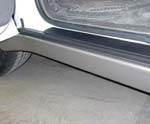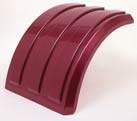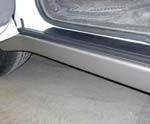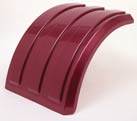Thermoforming Goes Paint-Free, Too
Thermoformed parts play two roles in the expanding field of in-mold decorating (IMD) of plastic parts: For injection molding, IMD begins by thermoforming a thin film into decorative shells that are placed in the injection mold cavity and then back-molded with a compatible substrate.
Thermoformed parts play two roles in the expanding field of in-mold decorating (IMD) of plastic parts: For injection molding, IMD begins by thermoforming a thin film into decorative shells that are placed in the injection mold cavity and then back-molded with a compatible substrate. But a second way to exploit decorative films has emerged. It’s called Thick Sheet Forming, or TSF, and it involves laminating or coextruding a decorative film or material onto a heavy-gauge (0.06- to 0.3-in.) sheet substrate for subsequent thermoforming directly into finished parts.
TSF is a proven approach; what’s new is its use with new-generation films and resins to achieve a Class A or brushed-metal surface, says John Cupstid, marketing director at Soliant, a supplier of dry-paint and metallic-look films. He cites the chrome-like front bumper fascia of a Mack Truck Co. vehicle that is to hit the road shortly.
In another breakthrough, industry sources say the first thermoformed TPO bumper fascia on a high-volume U.S.-built car will roll out within months. The details are still wrapped in secrecy. Until now, thermoformed TPO fascias have replaced injection molded versions only on low-volume programs.
Sizing up TSF decoration
Makers of decorative parts are busy assessing the strengths and limits of TSF. “The potential is huge,” says Albert Petersen, president of Advanced Ventures In Technology (AVT), a maker of thermoforming equipment. He sees major opportunities in exterior and interior parts for cars, trucks, and off-road (recreational and construction) vehicles.
One advantage of TSF is its relative simplicity, says Ed Crowe, technical director at Carlisle Engineered Products, an automotive processor in Crestline, Ohio. TSF requires only sheet and a forming machine, whereas IMD for injection molding requires two machines, two tools, and two starting materials. “TSF reduces variables and quality risks,” adds Crowe, noting that IMD requires trimming and robotic placement of inserts in the mold. Carlisle thermoforms Class A rocker panels for versions of General Motors’ 2003 Trailblazer SUV using a Soliant film and TPO sheet made from material supplied by Equistar Chemicals.
Thermoforming tools for TSF are much less costly than injection molds for IMD and they can be delivered much faster. But Crowe concedes that TSF is most suitable for large, flat panels and relatively low volumes, and it does have limits on draw depth, radii, and contours. Industry sources also warn that TSF parts could suffer color changes from excessive stretching and thinning of films in high-draw-ratio parts. And TSF is more limited than injection molding in incorporating holes or attachments.
Soliant’s Cupstid replies that TSF is already being done on high-output, four-station rotary and shuttle machines and now appears viable for higher volume runs of up to 100,000 parts. TSF is amenable to TPO materials, a low-cost, low-density option that is gaining popularity in Detroit.
A recent success for TSF, Cupstid notes, is the rear taillamp assembly of the Chevrolet Impala. It uses 0.060-in. high-impact ABS sheet laminated with a Soliant paint film. The assembly matches body colors. The program—managed by Decoma of Concord, Ont.—was recently extended to new versions of the Impala.
Hendrickson International in Joliet, Ill., makes the Class A bumper fascia for Mack Truck. The metallic, 20-sq-ft panel uses 0.187-in. thick ABS sheet to which a chrome-appearance film is laminated. The Soliant film is said to be durable, weatherable, and easy to form. A two-cavity male forming mold and shuttle-style machines are used.
“The Mack Truck fascia is lightweight and offers styling freedom,” claims Jeff Zawacki, Hendrickson’s marketing director. He says the fascia is 40% lighter than the steel/aluminum sandwich it replaces. Color consistency is maintained by using a modest draw ratio (under 50%), and deep undercuts are realized through innovative tooling.
Hendrickson’s roots are in metal bending, but it ventured into TSF because it saw limited room for growth in its traditional metal truck bumpers, Zawacki says. Its next targets for TSF are a front grille surround for a 2004 commercial truck, a line of aftermarket products, and sun visors.
Another TSF pioneer is Durakon Industries in LaPeer, Mich., which expanded beyond truck bed liners into large, decorative exterior automotive panels of TPO laminated with paint films (see p. 72). The first Durakon TSF applications appeared on the Chevrolet SSR roadster in late 2003. One is a twin-sheet running board made in a textured female mold. Another is a stone guard with Class A surface obtained with a glossy silver paint film from Avery Dennison. Durakon uses shuttle-style forming machines from AVT.
Durakon CEO Ed Gneiwek expects further inroads by TSF. Development is under way on front trim for the 2004 Jeep Wrangler and a rocker panel for the 2005 Buick LeSabre. “There’s potential in auto interiors, lawn-and-garden, RV, and marine-craft panels,” he adds.
Ted Klimek, Equistar Chemicals’ senior project manager for automotive TPOs, says process economics favor thermoformed TPO bumper fascias over injection molded rivals in low- to medium-volume runs. He also says thermoformed TPO bumper fascias exhibit better chip resistance and low-temperature impact strength than current injection molded TPO fascias that typically require painting.
Geiss Thermoforming LLC offers halogen-heated, in-line forming systems claimed to be especially suitable for Class A auto exterior panels. Tier One suppliers Decoma and ArvinMeritor have bought Geiss machines for their plants in Germany. In the past year, a Geiss machine was also bought by GE Plastics to develop applications for its PC-based Lexan SLX weatherable films. GE’s current marketing priority is to get SLX film used in IMD preforms, says Bob Johnson, product manager for SLX film and sheet. But he says SLX has considerable potential in TSF, too, especially in volumes up to 20,000 parts/yr. Developmental coextruded SLX sheets include clear and opaque versions with gauges of 0.125-in. or higher.
Clear versions of SLX/PC or SLX/PC/SLX sheet are intended for lighting, signs, point-of-purchase displays, and industrial screens. Opaque SLX/ABS-alloy and SLX/TPO sheets are for weatherable panels for off-road vehicles, lawn/garden equipment, and auto aftermarket parts. They could also replace fiberglass in RV and construction vehicle panels.
Mayco Plastics is developing TSF versions of its weatherable “molded-in-color” film, which saw limited initial use as an IMD insert on front and rear fascias of the 2002 and 2003 Dodge Neon. The four-layer, ionomer/PP sheet for IMD is 0.031 in. thick. For TSF, the PP substrate layer would be expanded to 0.3-in. Mayco sees potential in bumper fascia, body panels, and interior automotive parts.
Ford Motor Co. in Dearborn, Mich., recently installed a production cell including a Geiss in-line former with a clean-room enclosure. Ford plans to explore both IMD and TSF for Class A exterior panels. A Ford official says the OEM’s goals are to avoid building more paint facilities and reduce decorating costs.
Related Content
Making Gains in the Drain Game
AWD blends extrusion and thermoforming technologies with plenty of home-brewed equipment and processes to keep water away from where it isn’t supposed to be.
Read MoreThermoformed Container Keeps Battery Cells Safe
Despite last-minute design changes and other unexpected roadblocks, thermoformer TriEnda works with a key supplier on innovative reusable shipping container.
Read MoreOrigin Materials Unveils CapFormer for Producing PET Caps
Factory acceptance test completed at commercial scale.
Read MoreUS Merchants Makes its Mark in Injection Molding
In less than a decade in injection molding, US Merchants has acquired hundreds of machines spread across facilities in California, Texas, Virginia and Arizona, with even more growth coming.
Read MoreRead Next
Automotive Innovation Trend-Setting Technologies Garner SPE Awards
Paintless in-mold film decorating and carbon-fiber composites are making inroads in appearance and structural parts. Blow molding is finding new interior applications. And long-fiber thermoplastics are cutting weight and cost on the inside and outside of new passenger vehicles.
Read MoreThermoforming Shines in Exterior Vehicle Panels
Thermoformers are gaining a foothold in large exterior panels of specialized automobiles and utility vehicles.
Read MoreBeyond Prototypes: 8 Ways the Plastics Industry Is Using 3D Printing
Plastics processors are finding applications for 3D printing around the plant and across the supply chain. Here are 8 examples to look for at NPE2024.
Read More



















